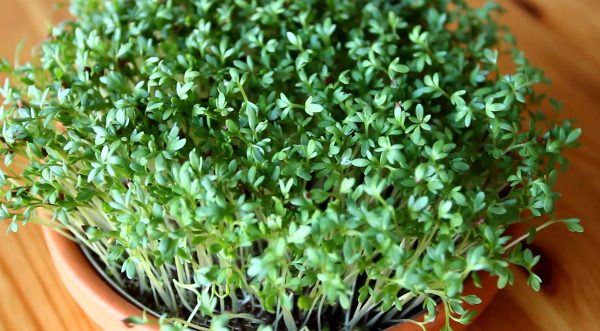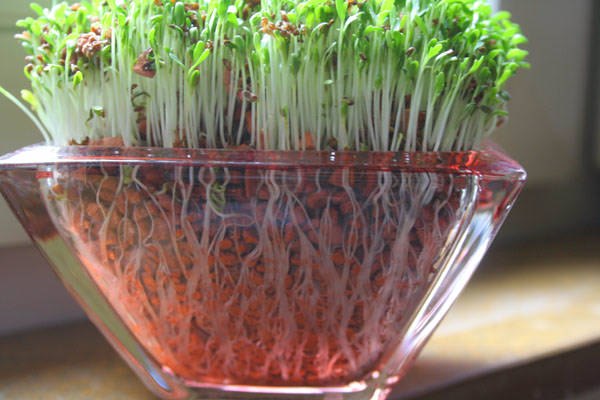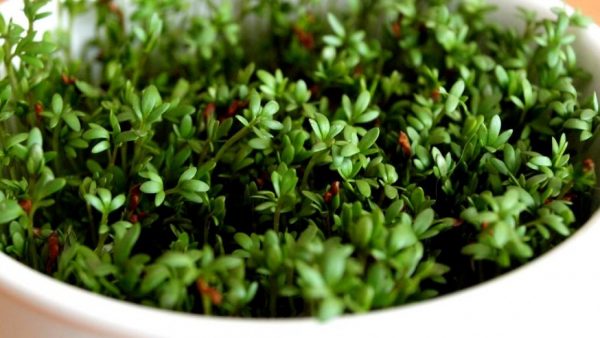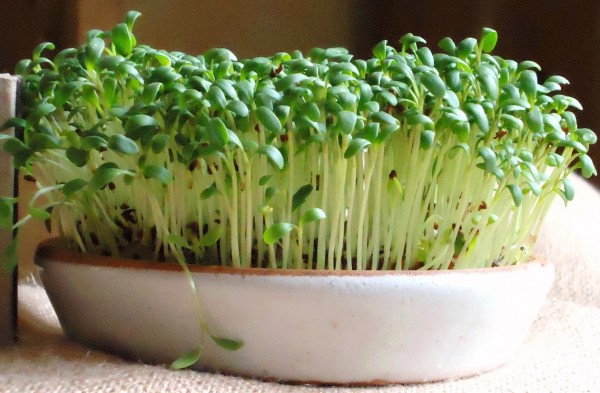How easy it is to grow watercress on a windowsill
Description
The annual vegetable plant watercress belongs to the genus Bugwort of the Cruciferous family. It is used in cooking, cosmetology, traditional medicine is widely used, fighting many ailments. Young leaves with a white stem are eaten. It has been known since antiquity, even Hippocrates believed that watercress purifies the blood, restores strength to the suffering.
All this is due to the amazing combination of elements useful for humans. In the composition of watercress, scientists discovered carotene, vitamins A, E, C, K, D, PP, almost all B vitamins, a huge amount of minerals, and besides them, proteins, sugars, essential and fatty oils, flavonoids, propsolin glycoside and alkaloid lepidine. It is hard to believe that delicate green leaves on white thin stems contain so much of everything that the human body needs.
Usually only young leaves are eaten. A plant that has reached maturity, flowering and fruiting, becomes not so tender, the concentration of nutrients in the leaves decreases. Oil is made from seeds, but for this you need to have equipment, at home they are insisted on vegetable oil. The taste of young sprouts is sharp, piquant, reminiscent of horseradish, radish or mustard. Three types of watercress are usually cultivated:
- curly;
- whole-leaved;
- sowing.
Curly lettuce has heavily cut leaves, which reflects the name, its varieties are early-ripening or mid-ripening. Early ripening ripens 3 weeks after the first shoots appear. Whole-leaved has larger, less ornate leaves. Among its varieties there are both early ripening (the most famous variety "Dukat") and late ripening. Sowing watercress is known for such early ripening varieties as "Dansky", "Zabava". Seeds of different species do not have noticeable differences, but grown plants differ in their appearance. Leaves, depending on the variety, are bright green, yellowish green or even gray.
Frosts of watercress are not scary, you can sow it on the site as soon as the snow melts, it becomes the first vitamin green that is eaten in spring. It grows very quickly, it is not at all picky about the soil. 100 g of greens contains only 32 kilocalories, which is why it is simply not replaceable for weight loss.
All this together makes watercress so popular and in demand. Originally from Asia, this amazing vegetable has taken root in all cuisines of the world. In Europe, it is introduced into salads, served with meat and fish, and decorated with sandwiches and soups. The French make soufflés, gravies and mousses from it. The Chinese serve it with sugar as a dessert - a combination that surprises Europeans, but is becoming more and more popular.
Watercress is known for its antioxidant and mild sedative properties, when used regularly, it can normalize sleep and blood pressure, and relieve depression. Traditional medicine widely uses it as an anti-inflammatory, expectorant, diuretic, wound healing, anti-sclerotic, sedative.Leaves treat many skin conditions, wounds and ulcers, chronic coughs, gallbladder problems and joint pain. Official medicine recommends consuming watercress regularly to prevent eye diseases and many types of cancer. Dentists advise to eat leaves, germinated seeds of watercress to prevent periodontal disease and strengthen tooth enamel.
Cosmetology uses the leaves, juice and seed oil of this wonderful salad for skin and hair care. Fighting pimples and acne, it shows great results. All of this is worth considering growing watercress at home.
Video "How to germinate watercress»
Video recommendations for sprouting watercress at home.
Agrotechnics
You can grow watercress on the windowsill all year round, from the moment of planting to consumption, a maximum of 2 weeks pass. This can get rid of seasonal vitamin deficiency, cure many ailments, help with weight loss. And only too high air temperature can interfere.
First you need to buy seeds. The expiration date must be indicated on the package, it is desirable that at least six months remain until its end. In addition, you need to carefully inspect the packaging - if the seeds get wet, then they ceased to be a suitable material for sowing. After making sure that the seeds have retained their suitability, you can proceed to the selection and preparation of dishes.
You can plant watercress in the ground so that it grows, almost like in a vegetable garden. To do this, put a layer of expanded clay for drainage in a low flower pot, on top of a soil rich in humus 3 cm thick. Before that, it is advisable to soak the seeds in warm, settled water, they are saturated with it while the soil is being prepared for them. Water with seeds is poured onto the prepared soil so that the seeds are distributed as evenly as possible. A centimeter layer of earth is spread on top of the seeds, watered, covered with cellophane or cling film, removed to a dark place with an air temperature of +7 degrees.
The next day, the film must be removed, the crops watered, then closed again. In a couple of days, shoots will appear, they can be thinned out so that there is a distance of 1 - 2 cm between the shoots. Then the pot can be opened, transferred to a warmer and brighter room, the temperature should not be higher than +15 degrees. Over the next week (approximately), you need to make sure that fresh air gets into the room, water the seedlings, loosen the ground, if it becomes compacted, turn the pot 180 degrees in relation to the sun. When the plants reach a height of 7-10 cm, and this usually happens 2 weeks after sowing, you can cut the crop with a sharp knife or scissors and eat. You need to cut off exactly as much as will go for food immediately, you do not need to store it.
Balcony watercress can be grown without soil. Any shallow plastic container will do. On its bottom, you need to lay a 2 cm layer of gauze, cotton wool or any cotton rag, moisten abundantly with water, lay the seeds on top, previously soaked for several minutes in warm water. Then the container is covered with foil and put away in a dark place. After the first sprouts appear, the film is removed and the sprouts are looked after in the same way as in the previous description.
If you wish, you can do without a cloth. The funniest way to grow is to sow watercress seeds in a tea strainer, put it in a cup, and spill it through with warm, settled water so that the bottom of the strainer touches the surface of the water. Friendly shoots should appear in a couple of days. The main thing is to remember to spray them with water (or add it to the cup), turn them 180 degrees daily and keep them out of the heat.
In a week and a half, all this can be eaten directly with the roots. If there are several strainers, you can arrange the cultivation so that there is always a portion of vitamin greens at the table, for example, for breakfast. With this cultivation, even younger greens are eaten than when grown in the ground.If you wish, you can not grow the leaves at all, but eating the sprouted seeds is also very useful.
Video "Watercress at home»
Video review on sowing watercress seeds and the process of their further growing at home.






